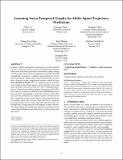| dc.contributor.author | Li, Yuke | |
| dc.contributor.author | Chen, Lixiong | |
| dc.contributor.author | Chen, Guangyi | |
| dc.contributor.author | Chan, Ching-Yao | |
| dc.contributor.author | Zhang, Kun | |
| dc.contributor.author | Anzellotti, Stefano | |
| dc.contributor.author | Wei, Donglai | |
| dc.date.accessioned | 2024-11-21T17:02:16Z | |
| dc.date.available | 2024-11-21T17:02:16Z | |
| dc.date.issued | 2024-10-28 | |
| dc.identifier.isbn | 979-8-4007-1192-3 | |
| dc.identifier.uri | https://hdl.handle.net/1721.1/157626 | |
| dc.description | MM’24, October 28 - November 1, 2024, Melbourne, Australia | en_US |
| dc.description.abstract | In order to predict a pedestrian's trajectory in a crowd accurately, one has to take into account her/his underlying socio-temporal interactions with other pedestrians consistently. Unlike existing work that represents the relevant information separately, partially, or implicitly, we propose a complete representation for it to be fully and explicitly captured and analyzed. In particular, we introduce a Directed Acyclic Graph-based structure, which we term Socio-Temporal Graph (STG), to explicitly capture pair-wise socio-temporal interactions among a group of people across both space and time. Our model is built on a time-varying generative process, whose latent variables determine the structure of the STGs. We design an attention-based model named STGformer that affords an end-to-end pipeline to learn the structure of the STGs for trajectory prediction. Our solution achieves overall state-of-the-art prediction accuracy in two large-scale benchmark datasets. Our analysis shows that a person's past trajectory is critical for predicting another person's future path. Our model learns this relationship with a strong notion of socio-temporal localities. Statistics show that utilizing this information explicitly for prediction yields a noticeable performance gain with respect to the trajectory-only approaches. | en_US |
| dc.publisher | ACM|Proceedings of the 5th International Workshop on Human-centric Multimedia Analysis | en_US |
| dc.relation.isversionof | https://doi.org/10.1145/3688865.3689481 | en_US |
| dc.rights | Article is made available in accordance with the publisher's policy and may be subject to US copyright law. Please refer to the publisher's site for terms of use. | en_US |
| dc.source | Association for Computing Machinery | en_US |
| dc.title | Learning Socio-Temporal Graphs for Multi-Agent Trajectory Prediction | en_US |
| dc.type | Article | en_US |
| dc.identifier.citation | Li, Yuke, Chen, Lixiong, Chen, Guangyi, Chan, Ching-Yao, Zhang, Kun et al. 2024. "Learning Socio-Temporal Graphs for Multi-Agent Trajectory Prediction." | |
| dc.contributor.department | Massachusetts Institute of Technology. Computer Science and Artificial Intelligence Laboratory | en_US |
| dc.identifier.mitlicense | PUBLISHER_POLICY | |
| dc.eprint.version | Final published version | en_US |
| dc.type.uri | http://purl.org/eprint/type/ConferencePaper | en_US |
| eprint.status | http://purl.org/eprint/status/NonPeerReviewed | en_US |
| dc.date.updated | 2024-11-01T07:53:57Z | |
| dc.language.rfc3066 | en | |
| dc.rights.holder | The author(s) | |
| dspace.date.submission | 2024-11-01T07:53:58Z | |
| mit.license | PUBLISHER_POLICY | |
| mit.metadata.status | Authority Work and Publication Information Needed | en_US |
